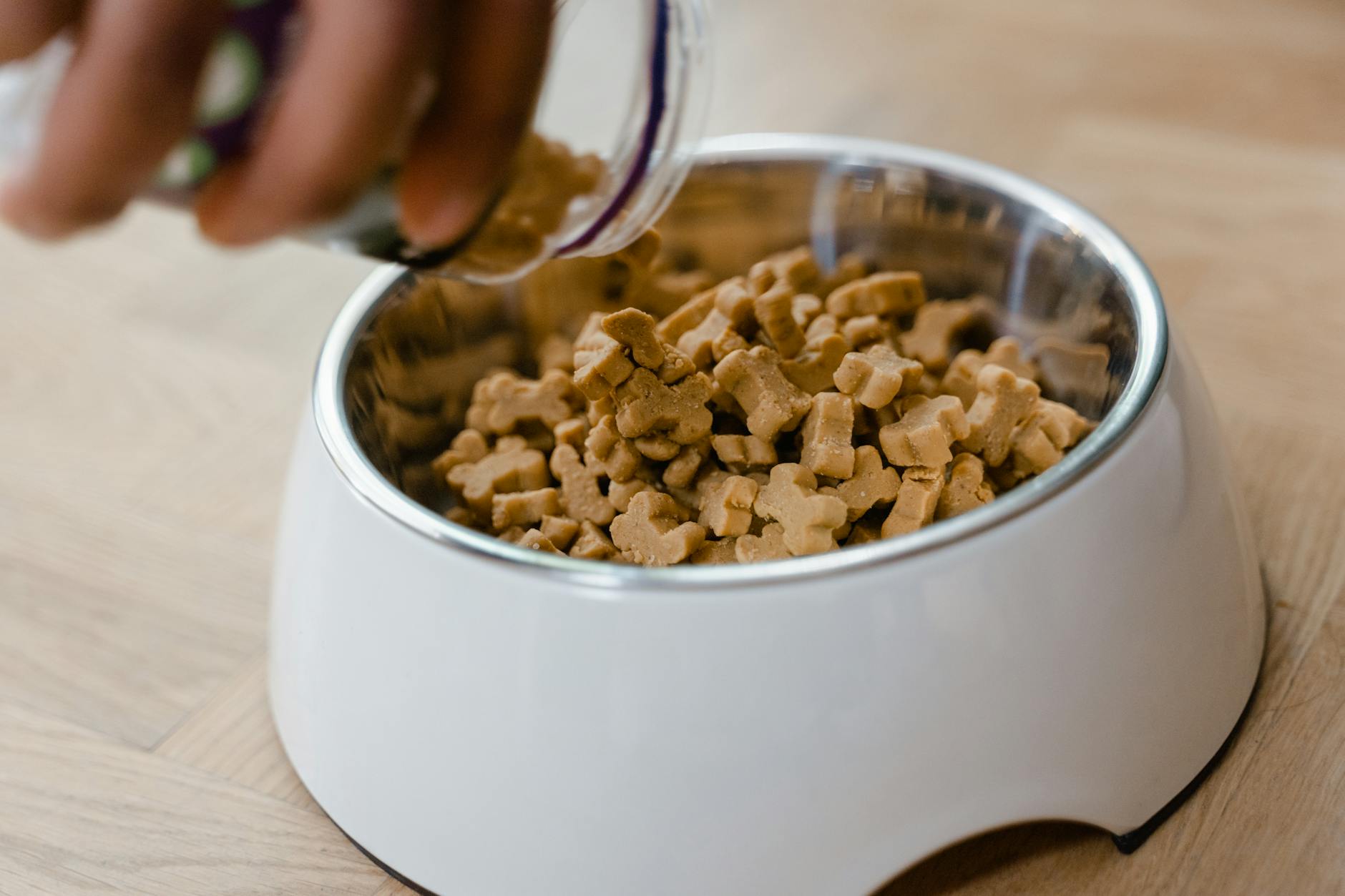Are you struggling to keep up with the ever-changing world of pet nutrition? As we approach 2025, understanding your furry friend’s dietary needs has become more complex than ever. 🐶🐱 With new research emerging and an overwhelming array of pet food options, it’s no wonder many pet owners feel lost.
Don’t worry, you’re not alone! Many pet parents find themselves asking: “Am I giving my pet the best nutrition possible?” The good news is that with the right knowledge, you can ensure your beloved companion thrives. In this beginner’s guide, we’ll demystify pet nutrition for 2025 and beyond, helping you make informed decisions about your pet’s diet.
From understanding the basics of pet nutrition to evaluating your pet’s current diet and customizing their meals, we’ll cover everything you need to know. Let’s dive in and discover how to give your furry friend the nutrition they deserve in this exciting new era of pet care! 🌟
The Basics of Pet Nutrition in 2025

Essential nutrients for pets
Pets require a balanced diet consisting of six essential nutrients: proteins, carbohydrates, fats, vitamins, minerals, and water. Each plays a crucial role in maintaining your pet’s health and vitality.
| Nutrient | Function | Sources |
|---|---|---|
| Proteins | Muscle development, tissue repair | Meat, fish, eggs |
| Carbohydrates | Energy source | Grains, vegetables |
| Fats | Energy, coat health | Fish oil, vegetable oils |
| Vitamins | Various bodily functions | Fruits, vegetables |
| Minerals | Bone health, cellular function | Meat, dairy, vegetables |
| Water | Hydration, temperature regulation | Fresh, clean water |
Latest advancements in pet food science
Recent breakthroughs in pet nutrition include:
- Personalized nutrition based on genetic profiles
- Probiotic-enhanced foods for gut health
- Novel protein sources like insect-based meals
- Functional ingredients targeting specific health issues
Tailoring diets to different life stages
Pets’ nutritional needs evolve throughout their lives. Puppies and kittens require more protein and calories for growth, while senior pets may need specialized diets to support joint health and cognitive function. Adult pets typically need a balanced maintenance diet.
Impact of technology on pet nutrition
Technology is revolutionizing pet nutrition in several ways:
- Smart feeders that dispense precise portions
- Wearable devices tracking pets’ activity and calorie needs
- AI-powered apps offering personalized diet recommendations
- Blockchain technology ensuring pet food traceability and safety
Now that we’ve covered the basics, let’s explore why pets have unique nutritional needs compared to humans.
Why Pets Have Unique Nutritional Needs

Now that we’ve covered the basics of pet nutrition in 2025, let’s dive into why pets have unique nutritional needs and the factors to consider when planning their diets.
Factors to Consider
When it comes to understanding your pet’s nutritional needs, several key factors come into play:
- Species-specific requirements
- Life stage
- Activity level
- Health conditions
- Body composition
Let’s explore each of these factors in more detail:
Species-specific requirements
Different animal species have evolved with distinct dietary needs. For example:
| Species | Primary Nutritional Focus |
|---|---|
| Dogs | Omnivorous diet with emphasis on protein |
| Cats | Obligate carnivores requiring high protein |
| Birds | Varied diets based on species (seed, fruit, or omnivorous) |
| Fish | Species-specific diets (herbivorous, carnivorous, or omnivorous) |
Life stage
As pets age, their nutritional requirements change:
- Puppies and kittens need more calories and nutrients for growth
- Adult pets require balanced maintenance diets
- Senior pets may need specialized diets to support aging bodies
Activity level
- Highly active pets, such as working dogs, require more calories
- Sedentary pets need fewer calories to prevent obesity
Health conditions
Certain health issues may necessitate special diets:
- Kidney disease: Low-phosphorus diets
- Diabetes: Controlled carbohydrate diets
- Food allergies: Limited ingredient or hypoallergenic diets
Body composition
- Overweight pets may need calorie-restricted diets
- Underweight pets might require higher-calorie foods
Understanding these factors is crucial for providing optimal nutrition tailored to your pet’s unique needs. In the next section, we’ll explore how to decode pet food labels to ensure you’re making the best choices for your furry friend.
How to Evaluate Your Pet’s Current Diet

Understanding Pet Food Labels
When decoding pet food labels, understanding ingredient lists is crucial. Ingredients are typically listed in descending order by weight. Here’s a breakdown of common components:
- Protein sources (e.g., chicken, beef, fish)
- Grains or carbohydrates (e.g., rice, corn, wheat)
- Fruits and vegetables
- Fats and oils
- Vitamins and minerals
- Preservatives and additives
| Ingredient Type | Examples | Purpose |
|---|---|---|
| Protein | Chicken, beef, fish | Muscle development, energy |
| Carbohydrates | Rice, corn, wheat | Energy, fiber |
| Fruits/Vegetables | Carrots, blueberries | Vitamins, antioxidants |
| Fats/Oils | Fish oil, flaxseed | Coat health, energy |
| Vitamins/Minerals | Vitamin E, calcium | Overall health, bone strength |
Navigating nutritional claims
Pet food labels often feature various nutritional claims. Here’s how to interpret them:
- “Complete and balanced”: Meets AAFCO nutritional standards
- “Natural”: Ingredients from plant, animal, or mined sources
- “Organic”: Follows USDA organic regulations
- “Grain-free”: Contains no grain ingredients
- “Limited ingredient”: Fewer ingredients, often for allergies
Identifying artificial additives
Artificial additives in pet food can include:
- Preservatives (e.g., BHA, BHT)
- Colors (e.g., Red 40, Yellow 5)
- Flavors (e.g., “animal digest”)
- Texturizers (e.g., carrageenan)
While some additives are safe, others may cause health concerns. Research each additive to make informed decisions.
Comparing organic and conventional options
Organic pet foods must meet strict USDA standards:
- No synthetic fertilizers or pesticides
- No antibiotics or growth hormones
- No genetically modified organisms (GMOs)
Conventional pet foods may contain these elements but must still meet safety standards. Consider your pet’s specific needs and consult with a veterinarian to choose the best option.
Now that we’ve decoded pet food labels, let’s explore how to customize your pet’s diet for optimal health.
Steps to Create a Balanced Diet Plan for Your Pet

Consult with Professionals
The first step in creating a balanced diet for your pet? Talk to the pros. A vet or a pet nutritionist is your best bet for crafting a meal plan that fits your pet’s specific needs. Sure, there’s a ton of information online, but it’s easy to miss the details that make all the difference—like your pet’s breed, age, or health history. Professional advice ensures you’re starting with a strong foundation for your furry friend’s well-being.
Breed-specific nutritional requirements
Different breeds have unique nutritional needs based on their size, energy levels, and predisposition to certain health issues. For example:
- Large breeds: Require controlled calcium intake to prevent skeletal issues
- Small breeds: Need more calorie-dense food due to higher metabolism
- Working breeds: Require higher protein and fat content for sustained energy
| Breed Size | Protein Needs | Fat Needs | Special Considerations |
|---|---|---|---|
| Small | High | Moderate | Dental health support |
| Medium | Moderate | Moderate | Joint health support |
| Large | Moderate | Low | Controlled growth rate |
Addressing common health concerns through diet
Tailoring your pet’s diet can help manage various health issues:
- Weight management: Low-calorie, high-fiber diets for overweight pets
- Joint health: Omega-3 fatty acids and glucosamine for arthritis
- Digestive issues: Easily digestible proteins and prebiotics for sensitive stomachs
Balancing homemade and commercial pet foods
Think about the difference between fresh, home-cooked meals and pre-packaged, processed snacks. Your pet feels the same way! Fresh food isn’t just tastier; it’s packed with nutrients that processed options often lack. Switching to fresh options—like lean meats, vegetables, or specially prepared fresh pet food—can improve energy levels, coat quality, and overall mood. It’s a simple shift with major payoffs. Every pet parent is an expert on their pet: likes, dislikes, eating habits, etc. Even I, as a pet nutritionist, double-check with my veterinarian when I change my pet’s diets.
While homemade diets offer control over ingredients, they can lack essential nutrients. A balanced approach might include:
- High-quality commercial food as a base
- Supplementing with fresh, pet-safe fruits and vegetables
- Occasional homemade treats using vet-approved recipes
3. Include Supplements Strategically
Even the best diet may need a little extra boost. Supplements can fill in gaps to make sure your pet is thriving. Omega-3 fatty acids, for instance, support a shiny coat and brain health, while probiotics aid digestion. For aging pets, joint support supplements can make a world of difference. But don’t just grab something off the shelf—check with your vet to get the right match for your pet’s unique needs. Supplements are like the finishing touch to a well-balanced diet.
Supplements can address specific health needs but should be used cautiously:
- Consult with a veterinarian before adding any supplements
- Start with small doses and monitor for adverse reactions
- Consider common supplements like fish oil, probiotics, and joint support formulas
Remember, every pet is unique. Regular check-ups with your veterinarian can help fine-tune your pet’s diet for optimal health and longevity.
4. Monitor and Adjust Over Time
A great diet plan isn’t static—it evolves. Regular checkups with your vet and health monitoring ensure the plan remains on track as your pet grows and their needs change. Testing for nutrient levels, weight management, and overall health indicators gives you the data you need to tweak their diet. Think of it like tuning a guitar: it’s not a one-and-done deal, but a continuous effort to keep things in harmony.
By following these steps, you’ll give your pet the best chance to live a long, healthy, and happy life. And isn’t that what we all want for our pets?

As we’ve explored, understanding your pet’s nutritional needs is crucial for their health and well-being in 2025. From grasping the basics of pet nutrition to recognizing why our furry friends have unique dietary requirements, we’ve covered essential ground. We’ve also delved into how to evaluate your pet’s current diet and the importance of customizing their meals to meet their specific needs.
Remember, a well-balanced diet tailored to your pet’s individual requirements is the foundation of their overall health. By taking the time to understand and address your pet’s nutritional needs, you’re investing in their long-term happiness and vitality. Start implementing these insights today, and watch your beloved companion thrive with the proper nutrition they deserve.
Further Reading
- Metabolomics in Companion Animal Nutrition: A Review
- Orthomolecular Nutrition in Veterinary Medicine: A Review
- Functional and Integrative Veterinary Medicine: A Review
- Nutrient Requirements of Dogs and Cats
- The Gut Microbiota of Dogs and Cats: A Review
- Sustainable Pet Foods: A Review
- Nutritional Management of Aging Dogs and Cats






